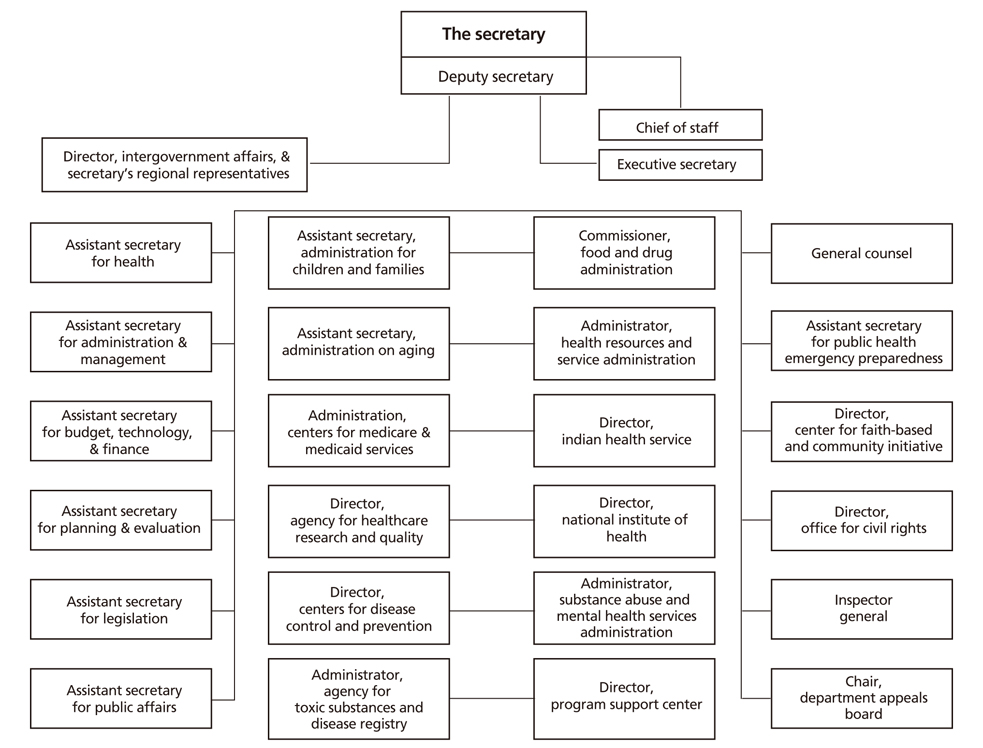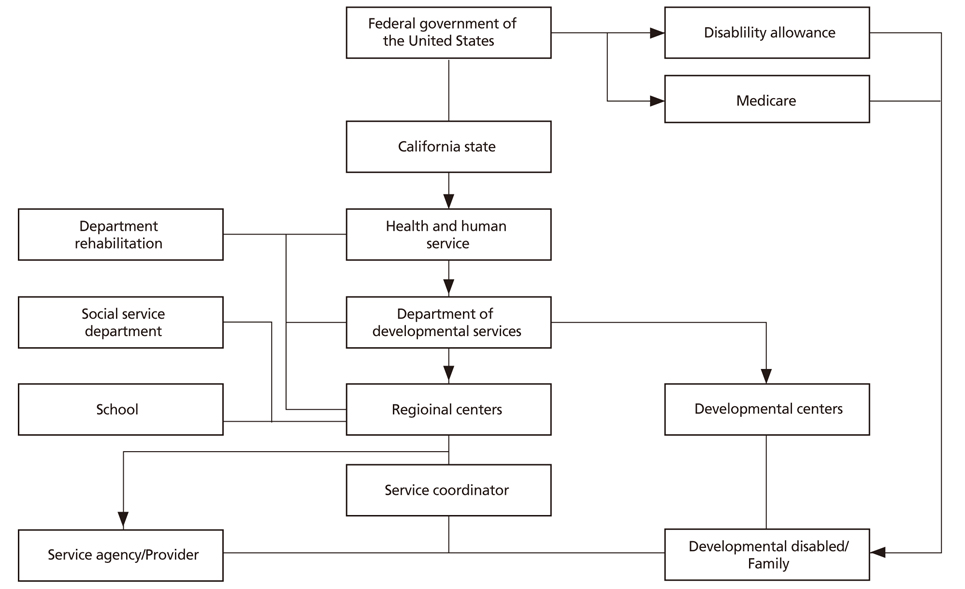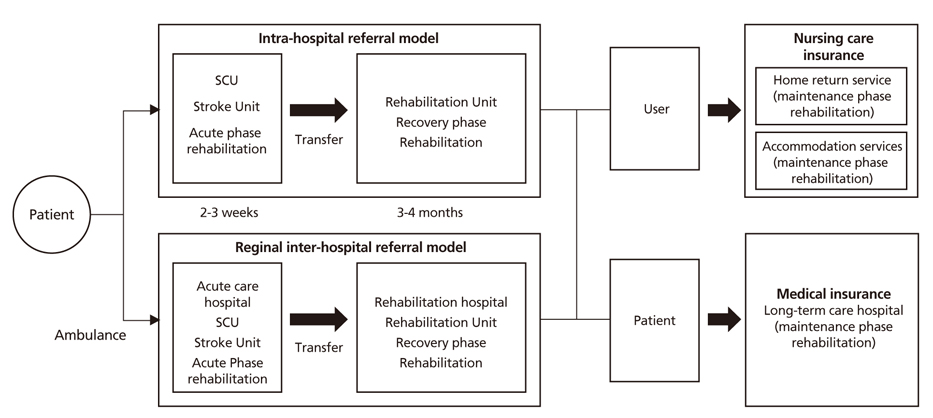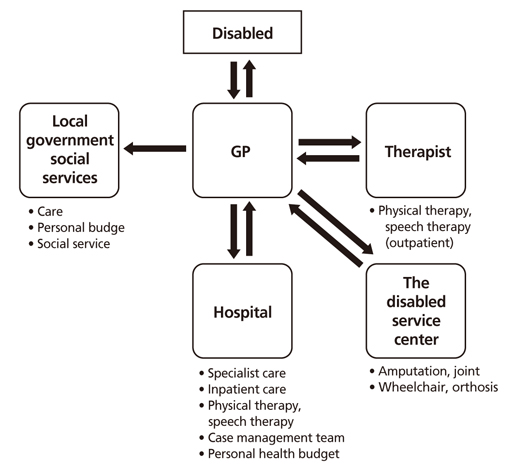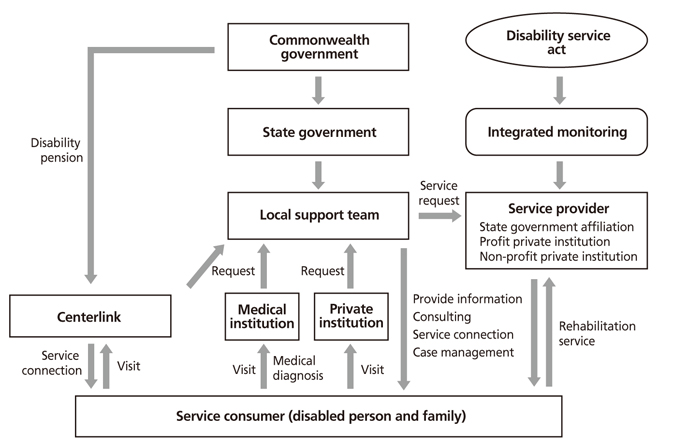J Korean Med Assoc.
2017 Nov;60(11):875-884. 10.5124/jkma.2017.60.11.875.
Models of rehabilitation medical service delivery system in the world
- Affiliations
-
- 1Department of Rehabilitation Medicine, Pusan National University School of Medicine, Yangsan, Korea. rmshin01@gmail.com
- 2Research Institute of Convergence for Biomedical Science and Technology, Pusan National University Yangsan Hospital, Yangsan, Korea.
- KMID: 2395593
- DOI: http://doi.org/10.5124/jkma.2017.60.11.875
Abstract
- In rehabilitation medicine, differences exist in programs and facilities of rehabilitation medical services provided for the acute, subacute, and chronic phases of a disorder caused by disease or trauma. The establishment of a rehabilitation medical delivery system is important as a way of providing appropriate rehabilitation medical services according to the timing and circumstances of the onset of a condition, but the domestic rehabilitation system is insufficient. The purpose of this study was to investigate the models of rehabilitation medical service delivery in representative countries such as the United States, Japan, and the United Kingdom, and to examine the characteristics of the system of each country. Rehabilitation medical service systems vary from country to country, but each country has a unified mechanism for service linkage in order to deliver various services in an organic relationship with service users (persons with disabilities and families) and providers (government and medical facilities). It is necessary to construct a rehabilitation medical delivery system according to the circumstances in Korea based on a comparative analysis of the systems of other representative countries.
Figure
Cited by 1 articles
-
Rehabilitation medicine healthcare supply and delivery system
Bum Sun Kwon
J Korean Med Assoc. 2017;60(11):860-863. doi: 10.5124/jkma.2017.60.11.860.
Reference
-
1. World Health Organization. World health report 2000: health systems: improving performance. Albany: World Health Organization;2000.2. Frier A, Barnett F, Devine S. The relationship between social determinants of health, and rehabilitation of neurological conditions: a systematic literature review. Disabil Rehabil. 2017; 39:941–948.
Article3. Gutenbrunner C, Nugraha B. Principles of assessment of rehabilitation services in health systems: learning from experiences. J Rehabil Med. 2017; 06. 28. [Epub]. DOI: 10.2340/16501977-2246.
Article4. Gutenbrunner C, Bickenbach J, Kiekens C, Meyer T, Skempes D, Nugraha B, Bethge M, Stucki G. ISPRM discussion paper: proposing dimensions for an International Classification System for Service Organization in Health-related Rehabilitation. J Rehabil Med. 2015; 47:809–815.
Article5. Kim K, Kang K, Lee M. Current status of use and satisfaction with family support services for families of children with disabilities. Spec Educ Res. 2016; 15:205–229.
Article6. Massof RW, Lidoff L. Issues in low vision rehabilitation: service delivery, policy, and funding. New York: AFB Press;2001.7. US Department of Health and Human Services. HHS orga-nization chart [Internet]. Washington, DC: US Department of Health and Human Services;cited 2017 Oct 30. Available from: https://www.hhs.gov/about/agencies/orgchart/index.html.8. Yoo SJ. The utilization of participation in private health support for private expansion of rehabilitation medical services [Internet]. Cheongju: Korea Health Industry Development In- stitute;2005. cited 2017 Oct 30. Available from: http://www.ndsl.kr/ndsl/search/detail/report/reportSearchResultDetail.do?cn=TRKO201100002624.9. California Department of Healthcare Services. California children's services [Internet]. Sacramento: California Depart-ment of Healthcare Services;cited 2017 Oct 30. Available from: http://www.dhcs.ca.gov/services/ccs/Pages/default.aspx.10. Kim BS. Study on development of referral system for medical rehabilitation. Seoul: National Rehabilitation Center;2004.11. Ministry of Health. Labour and Welfare. Health care and welfare measures for people with physical disabilities. Tokyo: Ministry of Health;Labour and Welfare;cited 2017 Oct 30. Available from: http://www.mhlw.go.jp/english/policy/care-welfare/welfare-disabilities/index.html.12. Joa UK. A study on the guideline of regional medical rehabilitation center [Internet]. Cheongju: Korea Health Industry Development Institute;2011. cited 2017 Oct 30. Available from: http://www.ndsl.kr/ndsl/search/detail/report/reportSearchResultDetail.do?cn=TRKO201600011576.13. Murray J, Ashworth R, Forster A, Young J. Developing a primary care-based stroke service: a review of the qualitative literature. Br J Gen Pract. 2003; 53:137–142.14. Shin YI. The construction of continuous rehabilitation service system (primary care trust for rehabilitation) for chronic disease after discharge [Internet]. Cheongju: Korea Centers for Disease Control and Prevention;2012. cited 2017 Oct 30. Available from: http://cdc.go.kr/CDC/cms/content/mobile/40/20640_view.html.15. Healthcare for London. Stroke rehabilitation guide: supporting London commissioners to commission quality services in 2010/11 [Internet]. London: Healthcare for London;cited 2017 Oct 30. Available from: http://www.londonprogrammes.nhs.uk/wp-content/uploads/2011/03/Acute-Stroke-Rehabilitation-Guide.pdf.16. Australian Society of Rehabilitation Counsellors Ltd. National Disability Insurance Scheme (NDIS) costs [Internet]. Hurlstone Park: Australian Society of Rehabilitation Counsellors Ltd;cited 2017 Oct 30. Available from: https://www.asorc.org.au/news/national-disability-insurance-scheme-ndis-costs.17. Thylefors I, Price E, Persson TO, von Wendt L. Teamwork in Swedish neuropaediatric habilitation. Child Care Health Dev. 2000; 26:515–532.
Article
- Full Text Links
- Actions
-
Cited
- CITED
-
- Close
- Share
- Similar articles
-
- Rehabilitation of the Disabled and Role of the Orthopaedic Surgeon
- Genetic Counseling in Korean Health Care System
- Development of Medical Rehabilitation System for Persons with Disabilities
- Rehabilitation medicine healthcare supply and delivery system
- Ideal delivery system of rehabilitation medical service

